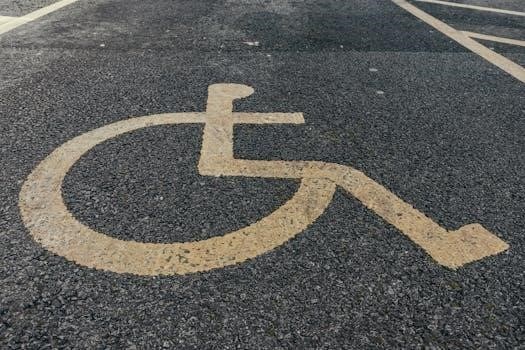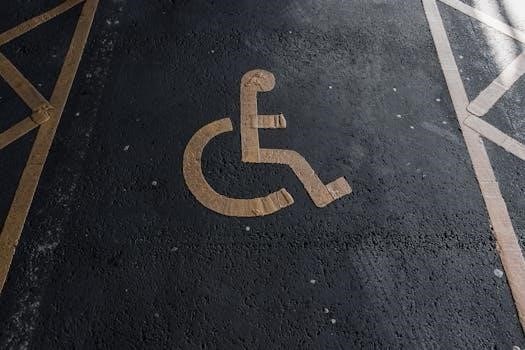Ram 1500 Warning Light Symbol Guide
The Ram 1500 is a reliable truck, communicating potential issues through warning lights. Understanding these lights is essential for maintaining your vehicle’s health. This guide helps decipher these symbols, ensuring you know what each light signifies and how to respond, promoting safe driving and vehicle longevity.
The Ram 1500, known for its reliability, uses a system of warning lights to alert drivers to potential issues. These lights are vital for maintaining vehicle health and safety. Understanding what each symbol means allows drivers to address problems promptly, preventing further damage and ensuring a secure driving experience.
Dashboard warning lights can indicate a range of issues, from minor concerns to critical problems requiring immediate attention. Recognizing the color and symbol is the first step in diagnosing the issue. Red lights typically signify serious problems, while yellow lights indicate potential issues that need investigating.

This guide provides a comprehensive overview of the Ram 1500’s warning light system. It explains the meanings behind various symbols and offers advice on how to respond when a light illuminates. By familiarizing yourself with these warnings, you can drive with confidence, knowing you can quickly identify and address any potential problems that may arise.
Regularly checking your dashboard and understanding the warning lights is crucial for responsible vehicle ownership. This knowledge empowers you to take proactive steps, ensuring your Ram 1500 remains in optimal condition and providing a safe and reliable driving experience for years to come.
Red Warning Lights⁚ Critical Issues

Red warning lights on your Ram 1500’s dashboard signal critical issues that demand immediate attention. These lights indicate problems that can potentially cause significant damage to your vehicle or compromise your safety while driving. Ignoring these warnings can lead to costly repairs or even dangerous situations.
When a red warning light illuminates, it is crucial to take immediate action; Safely pull over to the side of the road as soon as possible and assess the situation. Consult your owner’s manual to understand the specific meaning of the illuminated symbol. This will help you determine the severity of the issue and the appropriate course of action.
Some common red warning lights include the engine oil pressure warning light, the battery warning light, and the brake system warning light. Each of these lights indicates a potentially serious problem that requires prompt attention. Continuing to drive with a red warning light illuminated can exacerbate the issue and lead to further damage.
In many cases, a red warning light will necessitate a visit to a qualified mechanic. Do not attempt to diagnose or repair the problem yourself unless you have the necessary expertise and equipment. It is always best to err on the side of caution and seek professional assistance to ensure the issue is resolved correctly and safely.
Examples of Red Warning Lights and Their Meanings
Several red warning lights can appear on your Ram 1500’s dashboard, each signaling a specific critical issue. The engine oil pressure warning light, often depicted as an oil can, indicates that the engine is not receiving adequate lubrication. This can lead to severe engine damage if not addressed immediately.
The battery warning light, shaped like a battery, signifies a problem with the charging system. This could be due to a faulty alternator, a loose or corroded battery cable, or a failing battery. If this light comes on, your vehicle may eventually stall and be unable to restart.
The brake system warning light can indicate several issues, such as low brake fluid, a problem with the anti-lock braking system (ABS), or the parking brake being engaged. It’s crucial to have the brake system inspected promptly to ensure safe stopping ability.
Another critical red light is the engine temperature warning light, resembling a thermometer in liquid. It warns of an overheated engine, which can cause significant damage. Pull over immediately and allow the engine to cool down before checking the coolant level.
Ignoring these red warning lights can result in costly repairs and potentially dangerous driving conditions. Always consult your owner’s manual for detailed information and seek professional assistance when needed.
Yellow Warning Lights⁚ Potential Problems
Yellow warning lights on your Ram 1500’s dashboard indicate potential problems that require attention but may not be as critical as red warning lights. These lights often signal issues that could lead to more significant problems if left unaddressed.
The check engine light, often shaped like an engine, can indicate a wide range of issues, from a loose gas cap to a more serious engine malfunction. It’s advisable to have your vehicle inspected by a mechanic to diagnose the specific problem.
The ABS (Anti-lock Braking System) warning light, when illuminated in yellow, suggests a malfunction within the ABS. While your regular braking system may still function, the ABS may not activate during emergency braking situations, potentially increasing stopping distances.
The tire pressure monitoring system (TPMS) warning light alerts you to low tire pressure in one or more of your tires. Maintaining proper tire pressure is crucial for optimal fuel efficiency, handling, and tire wear. Check your tires and inflate them to the recommended pressure.
The electronic stability control (ESC) warning light, when lit in yellow, indicates a problem with the ESC system. This system helps maintain control of the vehicle during slippery conditions. A malfunction could reduce its effectiveness.
Addressing yellow warning lights promptly can help prevent more serious and costly repairs down the line. Consult your owner’s manual and seek professional assistance to diagnose and resolve the underlying issues.
Tire Pressure Monitoring System (TPMS) Warning Light
The Tire Pressure Monitoring System (TPMS) warning light is an essential feature in your Ram 1500, designed to alert you when one or more of your tires have significantly low pressure. This light typically appears as a horseshoe-shaped symbol with an exclamation point inside.
When the TPMS light illuminates, it indicates that one or more of your tires are below the recommended pressure level. Maintaining proper tire pressure is crucial for several reasons. It ensures optimal fuel efficiency, as underinflated tires create more rolling resistance, leading to increased fuel consumption.
Correct tire pressure also contributes to improved handling and stability, especially during braking and cornering. Underinflated tires can compromise your vehicle’s ability to respond effectively in these situations. Moreover, proper tire pressure promotes even tire wear, extending the lifespan of your tires and saving you money in the long run.
If the TPMS light comes on, the first step is to check the pressure of all four tires using a reliable tire pressure gauge. Inflate any tires that are below the recommended pressure, which can be found on a sticker inside your driver’s side doorjamb or in your owner’s manual.
After inflating the tires, the TPMS light may not immediately turn off. It might require driving for a short distance to allow the system to recalibrate. If the light persists after driving, there may be a problem with the TPMS sensors themselves, requiring professional attention.
ABS (Anti-lock Braking System) Warning Light
The ABS (Anti-lock Braking System) warning light is a crucial indicator of your Ram 1500’s braking system health. This light, typically displaying the letters “ABS,” signals a potential issue within the anti-lock braking system. The ABS is designed to prevent wheel lockup during hard braking, allowing you to maintain steering control.

When the ABS light illuminates, it means the system has detected a malfunction. This could range from a sensor issue to a problem with the ABS module itself. While your regular braking system will still function, the anti-lock feature might be disabled. In emergency braking situations, this could lead to wheel lockup and reduced steering control.

It’s important to address the ABS warning light promptly. While it doesn’t necessarily mean your brakes are about to fail, the ABS is a critical safety feature. Driving without it increases the risk of accidents, especially in slippery conditions or during sudden stops.
If the ABS light comes on, avoid panic stops and maintain a safe following distance. Schedule a diagnostic check with a qualified mechanic as soon as possible. They can pinpoint the exact cause of the problem and perform the necessary repairs.
Ignoring the ABS warning light can lead to more significant and costly repairs down the road. Regular maintenance and prompt attention to warning lights are essential for ensuring your Ram 1500’s safety and reliability.
Electronic Stability Control (ESC) Warning Light
The Electronic Stability Control (ESC) warning light in your Ram 1500 indicates the status of the vehicle’s stability system. Typically, this light depicts a car with tread lines or squiggly lines behind it. When illuminated, it signals that the ESC system is either actively engaged or experiencing a malfunction.
The ESC system is designed to enhance vehicle stability by detecting and mitigating skidding or loss of control. It uses sensors to monitor wheel speed, steering angle, and yaw rate. If the system detects a deviation from the intended path, it selectively applies brakes to individual wheels and adjusts engine torque to help the driver regain control.
If the ESC light flashes, it means the system is actively working to maintain stability. This is normal during slippery conditions or when making sudden maneuvers. However, if the light remains steadily on, it indicates a potential problem within the ESC system.
A constant ESC warning light suggests that the system may be disabled or malfunctioning. This could be due to a sensor failure, a problem with the ESC module, or other related issues. While your vehicle will still be drivable, you may not have the added stability assistance provided by the ESC system.
It’s crucial to address an illuminated ESC warning light promptly. Schedule a diagnostic check with a qualified technician to identify the root cause of the problem. Repairing the ESC system will ensure that your Ram 1500 maintains optimal stability and handling characteristics, especially in challenging driving conditions.
Green and Blue Lights⁚ Information and System Status
In your Ram 1500, green and blue lights on the dashboard primarily serve as indicators of system status and provide information about active vehicle features. Unlike red or yellow warning lights that signal potential problems, these lights generally denote that a system is engaged and functioning as intended.
Green lights often indicate that a system is on standby or ready to activate. For example, the turn signal indicators are green, informing you that the turn signals are in operation. Similarly, other green lights may illuminate when features like cruise control are activated or when certain safety systems are in a ready state.
Blue lights typically signify the activation of a more significant system. A common example is the high beam indicator, which illuminates when the high beams are turned on. This blue light serves as a reminder to the driver to avoid blinding oncoming traffic.
These lights are crucial for maintaining awareness of your vehicle’s operational status. They allow you to quickly assess which features are engaged and ensure that systems are functioning correctly. By monitoring these indicators, you can make informed decisions while driving and avoid potential hazards.
While green and blue lights are generally not indicative of critical issues, it’s essential to understand their meanings. Knowing which systems are active can help you optimize your driving experience and ensure safe operation of your Ram 1500.
Troubleshooting and Seeking Professional Help
When a warning light illuminates in your Ram 1500, the initial step is to identify the symbol and understand its meaning. Consult your owner’s manual for a comprehensive list of warning lights and their corresponding explanations. This will provide valuable insight into the potential issue affecting your vehicle.
For some warning lights, such as those related to low tire pressure or a loose fuel cap, you may be able to resolve the issue yourself. Check your tire pressures and inflate them to the recommended levels, or tighten the fuel cap to ensure a proper seal. If the warning light disappears after taking these steps, the problem is likely resolved.
However, for more serious warning lights, such as those indicating engine problems, brake system malfunctions, or transmission issues, it’s crucial to seek professional help. Continuing to drive with these warning lights illuminated can lead to further damage to your vehicle and potentially compromise your safety.
Contact a qualified mechanic or your local Ram dealership to schedule an appointment for diagnosis and repair. Explain the warning light you’re experiencing and any accompanying symptoms, such as unusual noises or changes in performance. This information will help the technician accurately diagnose the problem and recommend the appropriate solution.
Regular maintenance and prompt attention to warning lights are essential for keeping your Ram 1500 in optimal condition. By addressing issues early on, you can prevent costly repairs and ensure a safe and reliable driving experience.

